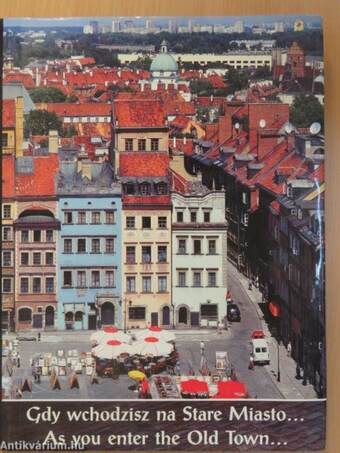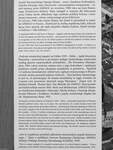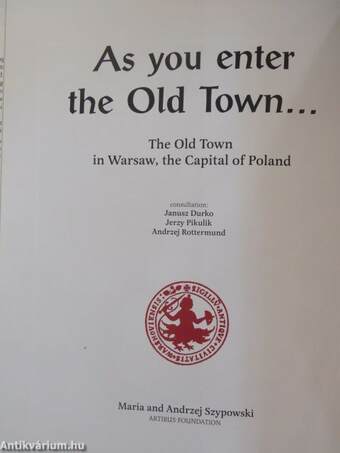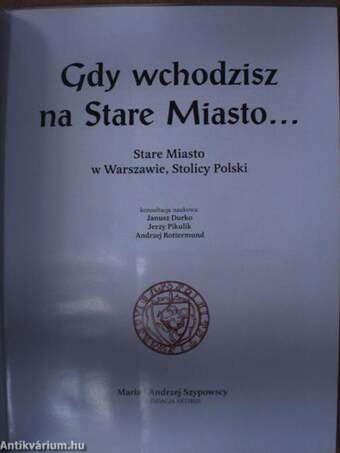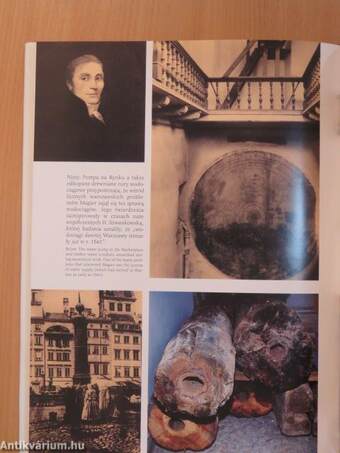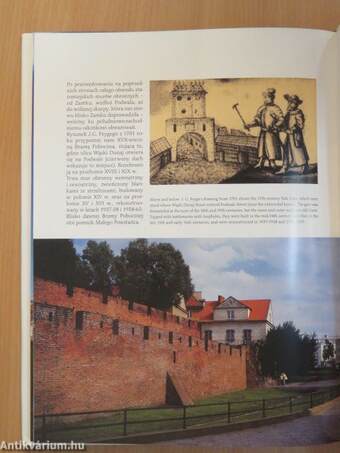1.062.799
kiadvánnyal nyújtjuk Magyarország legnagyobb antikvár könyv-kínálatát

VISSZA
A TETEJÉRE
JAVASLATOKÉszre-
vételek
Gdy wchodzisz na Stare Miasto.../As you enter the Old Town
Stare Miasto w Warszawie, Stolicy Polski/The Old Town in Warsaw, the Capital of Poland
| Kiadó: | Artibus Foundation |
|---|---|
| Kiadás helye: | |
| Kiadás éve: | |
| Kötés típusa: | Fűzött keménykötés |
| Oldalszám: | 254 oldal |
| Sorozatcím: | |
| Kötetszám: | |
| Nyelv: | Angol Lengyel |
| Méret: | 33 cm x 25 cm |
| ISBN: | 83-86879-31-9 |
| Megjegyzés: | Színes és fekete-fehér fotókkal. |
naponta értesítjük a beérkező friss
kiadványokról
naponta értesítjük a beérkező friss
kiadványokról
Fülszöveg
,Ur-:v I j í MBi Zespói Warszawskiego Starego Miasta - wraz z Zamkiem Królewskim, Katedra Swi^tego Jana Chrzciciela i staromiejskimi swi^tyniami - zostal wpisany przez UNESCO we wrzesniu 1980 roku na List? Swiatowego Dziedzictwa Kultury. Wpis nast^pil w uznaniu dia dokonania przez Polsk? dziela odbudowy tego symbolu polskiej kultury i narodowej tozsamosci, celowo zniszczonego przez hitleryzm. W czerwcu 1980 roku Ojciec Swi^ty Jan Pawef II powiedzial w siedzibie UNESCO w Paryzu: „Naród jest tq wielk^ wspólnot^ ludzi, których I3CZ3 rózne spoiwa, ale nade wszystko wlasnie kultura. Naród istnieje «z kultury» i «dla kultury»..." In Septemberl980 the Old Town in Warsaw - together with the Royal Castle, the Cathedral of St John the Baptist and Old Town churches - was entered on the UNESCO World Heritage List in recognition of the effort put by the Polish people to rebuild this symbols of Polish culture and national identity, an object of savage attacs by Nazi invaders. In June 1980 John... Tovább
Fülszöveg
,Ur-:v I j í MBi Zespói Warszawskiego Starego Miasta - wraz z Zamkiem Królewskim, Katedra Swi^tego Jana Chrzciciela i staromiejskimi swi^tyniami - zostal wpisany przez UNESCO we wrzesniu 1980 roku na List? Swiatowego Dziedzictwa Kultury. Wpis nast^pil w uznaniu dia dokonania przez Polsk? dziela odbudowy tego symbolu polskiej kultury i narodowej tozsamosci, celowo zniszczonego przez hitleryzm. W czerwcu 1980 roku Ojciec Swi^ty Jan Pawef II powiedzial w siedzibie UNESCO w Paryzu: „Naród jest tq wielk^ wspólnot^ ludzi, których I3CZ3 rózne spoiwa, ale nade wszystko wlasnie kultura. Naród istnieje «z kultury» i «dla kultury»..." In Septemberl980 the Old Town in Warsaw - together with the Royal Castle, the Cathedral of St John the Baptist and Old Town churches - was entered on the UNESCO World Heritage List in recognition of the effort put by the Polish people to rebuild this symbols of Polish culture and national identity, an object of savage attacs by Nazi invaders. In June 1980 John Paul II proclaimed in the UNESCO headquarters in Paris: 'A nation is a great community of people joined together by various links, but above all by culture. A nation exists "from culture" and "for culture".' „Podczas niemieckiej napasci na Polske 1939... Hitler... z^dal zburzenia Warszawy i wzniesienia w jej miejsce malego niemieckiego miasteczka wedlug planów nazistowskich architektów... [Po Powstaniu Warszawskim 1944 roku] centrum miasta wraz z jego koscioiami i spalonym Zamkiem zostalo przez okupanta wysadzone w powietrze... Sposród 1,2 miliona mieszkaríców, wsród ruin i zgliszcz zniszczonego w 85 procentach miasta pozostali jedynie nieliczni... Tym bardziej zdumiewaj^- ce jest to, ze powracaj^cy do miasta mieszkancy w ci^gu niewielu lat z morza ruin ponownie stworzyli swoj^ Warszawy." Jürgen Lotz, dr Mathias Schmidt, Thomas Veser: Das Welterbe der UNESCO. Naturwunder und Kulturschatze unserer Welt. Nord- und Mitteleuropa. UNESCO Swiatowe Dziedzictwo Kulturalne i Naturalne. Skarby Kultury i Przyrody Swiata. Európa Pólnocna i Srodkowa. Przeklad zjezyka niemieckiego Bogdán Bacik. Wydawnictwo Penta, 1997. 'During the Germán invasion on Poland in 1939... Hitler... demanded destruction of Warsaw, Poland's political centre, and, in its place, the construction of a small Germán town built according to plans drawn up by Nazi architects... [Following the Warsaw Uprising of 1944], the city centre, together with its churches and the burnt out shell of the Castle, were blown up by the invaders... Of the 1.2 millión inhabitants, only few survived in the smouldering ruins of the city, which was 85% destroyed... It is therefore all the more surprising that the people of Warsaw restored their city from the sea of rubble in just a few years.' [Polish translation of the Germán originál, Penta]: Jürgen Lotz, dr Mathias Schmidt, Thomas Veser: Das Welterbe der UNESCO. Naturwunder und Kulturschatze unserer Welt Nord- und Mitteleuropa. VS Verlaghaus Stuttgart GmbH, 1997. UNESCO World Cultural and National Heritage. The World's Cultural and Natural Monuments. Northern and Central Europe. „Jest to wyj^tkowy przyklad calkowitej rekonstrukcji zespolu historycznego..." Zapis w publikacji Centrum Swiatowego Dziedzictwa UNESCO. Biuletyn Polskiego Komitetu Narodowego ICOMOS, 1999. 'This is a unique example of a complete reconstruction of a whole historie complex...' From a publication ofthe UNESCO World Heritage Centre, Bulletin ofthe Polish ICOMOS Committee, 1999. Vissza
Témakörök
- Idegennyelv > Idegennyelvű könyvek > Többnyelvű könyvek
- Művelődéstörténet > Kultúra > Története
- Helytörténet > Külföldi > Városok
- Művészetek > Fotóművészet > Albumok > Külföldi
- Művészetek > Fotóművészet > Albumok > Tematikus
- Művészetek > Fotóművészet > Idegen nyelv > Többnyelvű
- Művészetek > Fotóművészet > Témái > Városok > Külföldi
- Idegennyelv > Idegennyelvű könyvek > Lengyel
Megvásárolható példányok
Nincs megvásárolható példány
A könyv összes megrendelhető példánya elfogyott. Ha kívánja, előjegyezheti a könyvet, és amint a könyv egy újabb példánya elérhető lesz, értesítjük.



